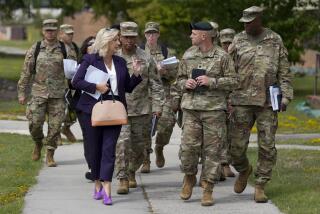Should We Bring Back the Draft?
- Share via
Military conscription was eliminated in 1973 at the end of the Vietnam War and, since then, the U.S. military has relied on an all-volunteer force. But with the armed services failing to meet their recruiting targets, the draft has reemerged in the media and among some in Congress as a solution to the military’s recruiting problems. That’s unfortunate because going back to the draft system would be a bad idea.
Our judgment is based on a series of economic arguments. First, the cost of a draft force is higher than that of an all-volunteer force of the same size. By definition, volunteers find military service an attractive occupational choice, whereas draftees, also by definition, have better civilian alternatives or stronger preferences for civilian endeavors. Turnover is higher under a draft system because draftees are not serving voluntarily. Training costs will be higher, too, because those who leave need to be replaced. The bottom line is that more individuals would need to be trained in a draft force to meet a given level of military readiness.
A draft force is also less productive than a volunteer force of the same size. High turnover means it will be composed of relatively few experienced career personnel. A draft force is also a less motivated force. Because draftees are less likely to seek and get promotions and to complete a full military career, they are less likely to perform beyond the minimum level. In addition, since draftees can be paid less and replaced nearly at will, there is little point to using military personnel economically.
Although the pace of military operations has increased in recent years, the current level of military personnel requirements is low relative to what it would be in an all-out conflict. Conscription makes sense when huge numbers of recruits are needed quickly, as in World War II or even the Vietnam War. That is why the authority exists to revert to a draft in case of national emergency. But that is not the situation today nor is it likely to be in the near future.
Finally, the military is getting more high tech. Improvements in the quality and complexity of equipment mean that high-aptitude personnel, especially the more-experienced career personnel, will be even more important in the military. When systems are more complex, longer and more expensive training is required. These factors further increase the efficiency of a volunteer force relative to a draft force. A volunteer force, with its lower turnover rate, will induce more personnel to stay longer and enable the military to reap a return on more expensive training.
If a volunteer force is better, how should today’s recruiting problems be solved? The military and Congress are putting in place policies that address the recruiting shortfalls, including increasing the number of recruiters, advertising, educational benefits, enlistment bonuses and basic pay. These initiatives, some of which have yet to begin, need time to take effect. Congress has just approved legislation that substantially increases military pay and retirement benefits. This should improve retention and reduce the call for new recruits.
Beyond that, the military needs to rethink who and how it recruits. The traditional target population--high school graduates who defer higher education--is shrinking, given that most high school graduates now attend college. To attract college-bound youth, the military should reduce its reliance on programs that require service members to defer their college education (like the GI Bill), expand programs that allow college before military service and pay more to those who enlist with some college education.
Recruiting processes also need to be reengineered. For example, the military should start “e-recruiting.” This means using the Internet to not only attract and inform potential recruits but to process them into the service. Research by Rand Corp.and others shows that these approaches can be highly effective in mitigating military recruiting and retention problems.
The all-volunteer force has survived for 26 years, through good and bad economic conditions and through a diverse array of national security threats. With hard work, innovative policies and time to let current initiatives take effect, the nation can survive the current recruiting crisis and emerge with a strong, well-prepared military force. Returning to the draft is not the answer.
More to Read
Sign up for Essential California
The most important California stories and recommendations in your inbox every morning.
You may occasionally receive promotional content from the Los Angeles Times.













